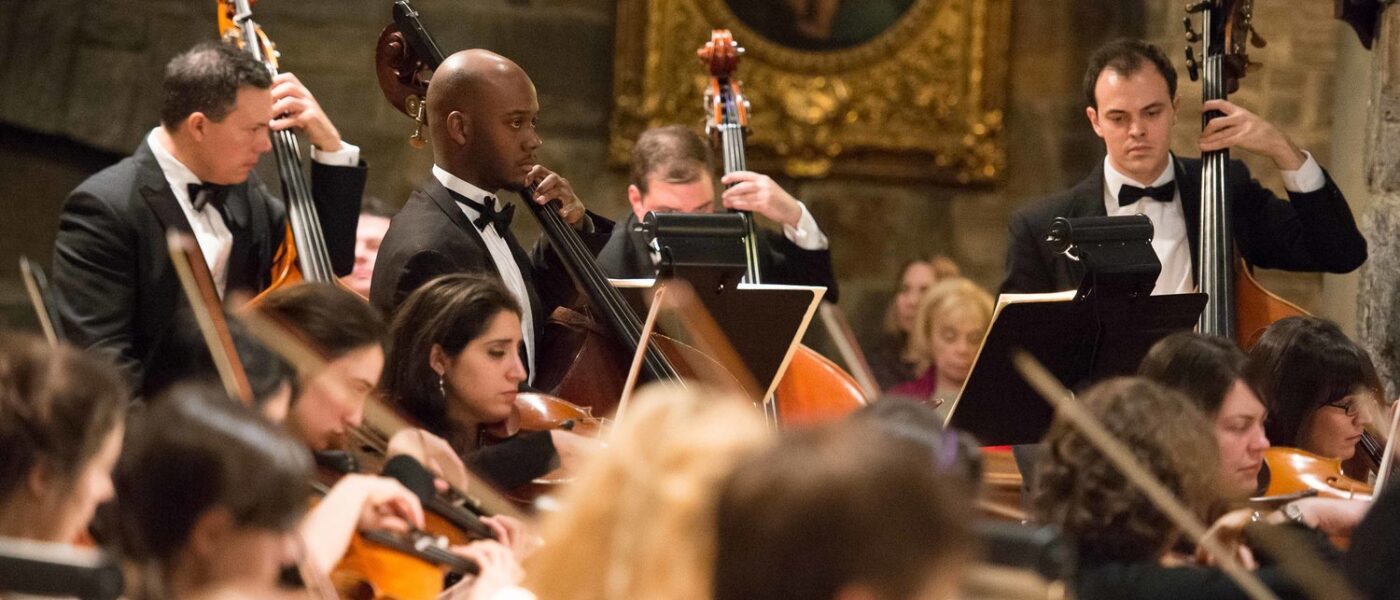Modus Operandi Orchestra presents “The Glory of Vienna: An Evening of Mozart and Beethoven” in Review
The Modus Operandi Orchestra; Justin Bischof, Music Director and Conductor
St. Mary Church, Long Island City, New York
April 29, 2023
It was especially uplifting this weekend, as we emerge from the pandemic’s death blows to the performing arts, to attend the most recent concert by the Modus Operandi Orchestra under music director and conductor Justin Bischof. In a program entitled “The Glory of Vienna: An Evening of Mozart and Beethoven,” they showed that not only can local orchestras flourish again, but audiences are ready and eager for them. St. Mary’s Church in Long Island City, a large, beautiful, and acoustically live venue, was packed for this concert. It was so packed that the front ticket desk was overwhelmed, and the concert started twenty minutes late. This listener, often needing to watch the clock, grew actually fairly impatient about that (and there ought to be some measures in place to prevent it), but as the conductor Justin Bischof announced “it is the price of success.” A success it was, on all fronts.
With an excellent conductor and corps of fine musicians – twenty-eight strings, plus healthy winds, brass, and timpani – they had the spirit, skill, and energy they needed to bring to life a program that included Beethoven’s Coriolan Overture, Op. 62 and Symphony No. 7, as well as Mozart’s Symphony No. 35 (“Haffner”). In addition, with guest soprano Laura Léon, they performed Mozart’s Exsultate Jubilate, K. 165, and No, no che non sei capace, K. 419. Their promotional material announced that the concert would “celebrate the riches and majesty of works that either premiered in Vienna or that have a strong connection to this glittering European capital city,” and that celebration was palpable.
Justin Bischof introduced each work with the spoken equivalent of program notes, and though this listener at first thought “Oh, no, more waiting,” his comments were brief and illuminating. Maestro Bischof strikes the perfect balance between high-level professionalism and the ability to reach out to the non-musicians in the audience. His comments were simple and entertaining enough for the many young listeners present but also held valuable information for the adults (such as noting that Mozart’s “Haffner” Symphony manuscript can be found right across town at the Morgan Library). His comments on the Coriolan Overture highlighted the contrasting themes of war and peace in it, and the audience was rapt from its dark dramatic opening to its whispering close.
Mozart’s Symphony No. 35, the “Haffner,” was opened with energy and precision. One could close one’s eyes and easily imagine oneself in any of the major symphony halls of the world hearing a more renowned orchestra. One followed each theme, each voice, and each entry with the excitement that was meant to imbue the “ennobling” ceremony of the Haffner for whom the work was commissioned (despite further transformations before the work became the Symphony No. 35). The Andante movement spotlighted the expressive unity of the orchestra, and the Menuetto enjoyed its characteristic restraint. The Presto finale impressed as unusually clear, especially given the brisk tempo. It closed with rousing ebullience.
The famous solo motet, Exsultate Jubilate for soprano and orchestra, followed. Maestro Bischof gave a glowing introduction to Laura Léon , and she lived up to it fully. Her melismatic singing in the first section – and the final Alleluja section – was dazzling, but it was the sublime softness and expressivity at the end of the Tu virginem corona section that had me thinking we will be hearing much more from this talented musician. Following the Exsultate was the “insertion” aria (written to insert into an opera by Pasquale Anfossi) No, no, che non sei capace. It is an angry aria of disappointed love, with its anger made manifest in ridiculously difficult high notes – yet thanks to the uncanny gifts of Ms. Léon, one still heard in it the transcendent beauty of Mozart rather than mere shrieking. She sang with amazing ease and fluidity. One occasionally had trouble matching the diction with the printed text, but that may have been the overwhelming reverberation obliterating consonants. Brava to this young talent!
After the obligatory pitch for funds from Maestro Bischof, the program proceeded with Beethoven’s Symphony No. 7. He also set the scene historically by describing the orchestra that played it as having included Meyerbeer, Hummel, and Salieri. That warrants a few moments of awe, but the playing lived up to this awe. The first movement projected a jubilance enough to overcome the late hour. The flutes shone particularly in the movement’s big transition, but the winds in general shone throughout. The Allegretto movement, one of the divine miracles in music, held the audience rapt, as one noticed strikingly in the soft fugal section. It was partly striking because there were such very young children held spellbound throughout as if watching an action movie. With worries over attention deficits and smartphone addictions, this heightening of sensibilities in young audiences represents a success that will bear fruit in the generations to come. Thanks to the enveloping reverberations of St. Mary’s church, those children tapping on air drums and parents rocking little ones on laps were barely noticeable – except for what they added to the overall joy. A rare few minor glitches occurred, but all was always controlled. The Presto movement offered many opportunities for the horns to shine, even if the upper strings seemed more “caffeinated” than the lower (as often happens – and there were only four celli and three basses listed at that), but by the final exuberant movement, there was hardly a soul able to keep from dancing.
Check the MOO website to add future concerts to your calendars, but (for now) perhaps make allowances for an extra twenty minutes. Bravi tutti!

